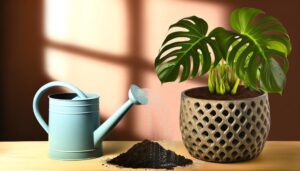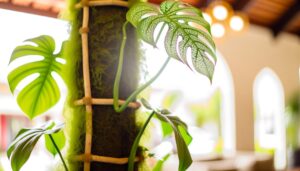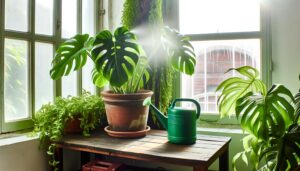How to Make Monstera Adansonii Fuller? Effective Techniques!
To make your Monstera Adansonii fuller, place it in bright, indirect sunlight and avoid direct sun. Use well-draining soil mixed with potting soil, perlite, and orchid bark.
Water when the top 1-2 inches are dry and maintain humidity between 60-80%. Fertilize every 4-6 weeks with a diluted, balanced fertilizer.
Prune with sterilized tools above a node to stimulate new shoots. Support your plant with moss poles or trellises, and rotate it 90 degrees weekly for even growth.
Inspect for pests regularly and treat as needed. These steps will promote lush growth and a fuller appearance.
There’s more to explore for the best results.
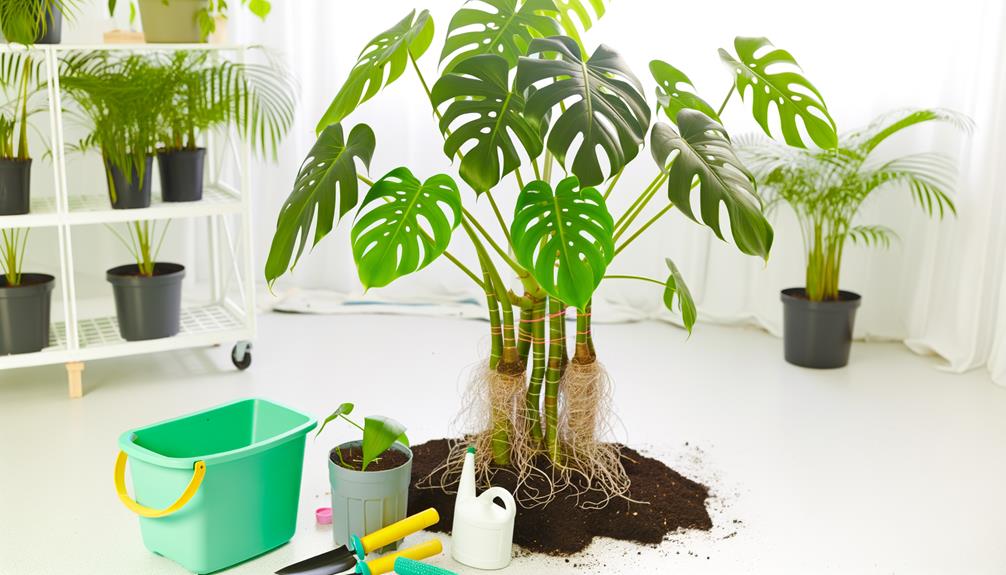
Key Takeaways
- Prune above a node with sterilized tools to stimulate new shoots and bushier growth.
- Provide bright, indirect sunlight and rotate the pot weekly to ensure even growth.
- Use well-draining soil mix and water when the top 1-2 inches are dry to avoid root rot.
- Maintain humidity between 60-80% with a humidifier or by misting leaves regularly.
- Apply balanced, diluted fertilizer every 4-6 weeks to promote healthy and fuller foliage.
Proper Light Conditions
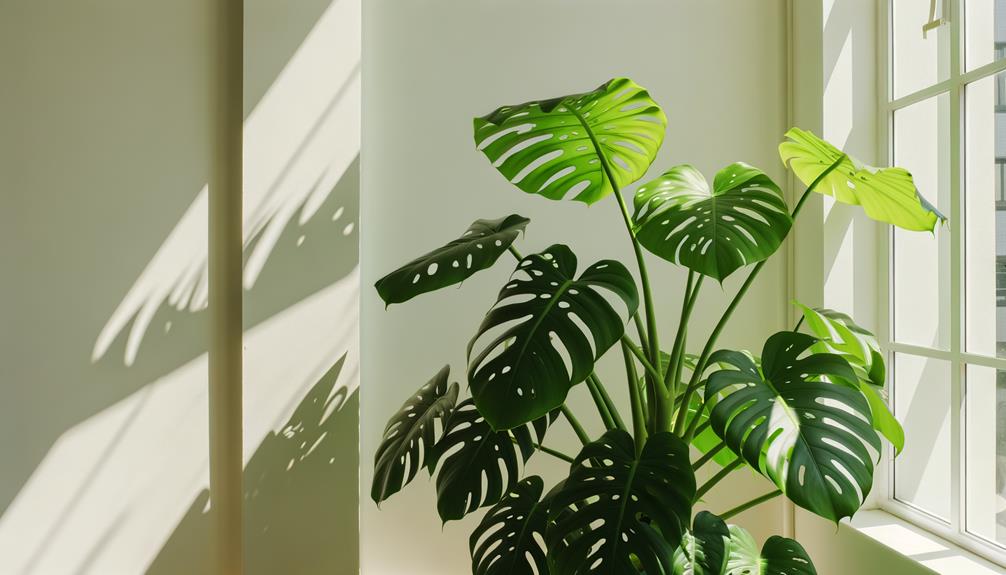
When optimizing light conditions for your Monstera Adansonii, make sure it receives bright, indirect sunlight to promote fuller growth. Place your plant near an east or north-facing window where it can benefit from diffused light. Direct sunlight can scorch the leaves, causing damage and stunted growth.
If natural light is inadequate, use artificial grow lights with a spectrum suitable for photosynthesis. Maintain a light intensity of around 10,000 to 20,000 lux. Rotate the plant every few weeks to guarantee even light distribution and prevent asymmetrical growth.
Consistent lighting helps the plant produce energy efficiently, essential for robust leaf and stem development. Monitor light conditions regularly and adjust as needed to keep your Monstera thriving.
Ideal Soil Mix
To complement the best light conditions, ensure your Monstera Adansonii thrives in a well-draining soil mix rich in organic matter and aeration. Use a combination of high-quality potting soil, perlite, and orchid bark. Aim for a ratio of 2:1:1 to guarantee efficient drainage and root oxygenation.
The potting soil provides necessary nutrients, while perlite enhances drainage and prevents compaction. Orchid bark aids in aeration, mimicking the plant’s natural epiphytic environment. Avoid heavy soils that retain excess moisture, leading to root rot. Incorporate peat moss or coco coir to maintain moisture without waterlogging.
Regularly check soil pH, aiming for a slightly acidic to neutral range (5.5-7). This balanced mix promotes vigorous growth and a fuller Monstera Adansonii.
Watering Schedule
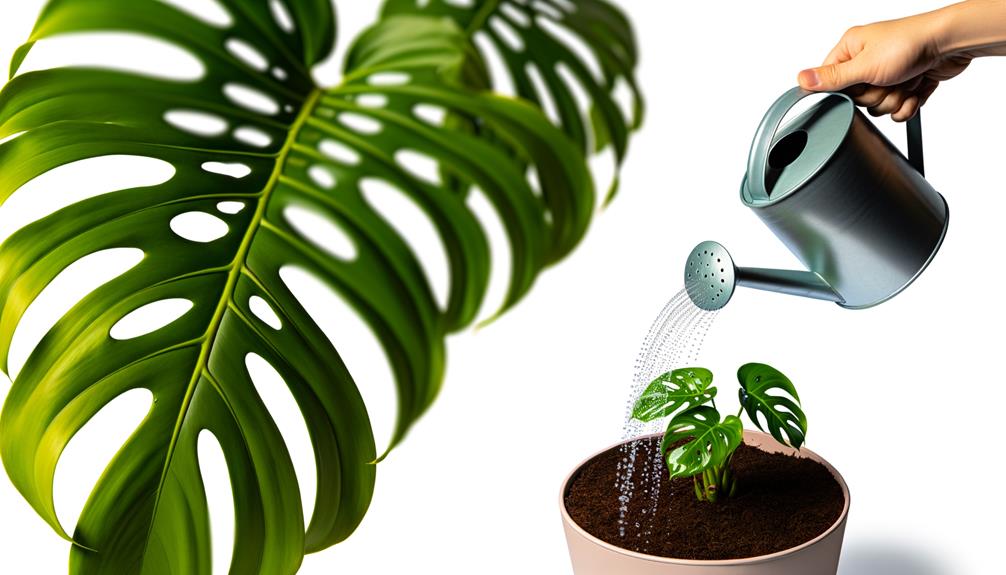
A consistent watering schedule is crucial for maintaining the health and fullness of your Monstera Adansonii. Aim to water your plant when the top 1-2 inches of soil feel dry. Insert your finger into the soil to check moisture levels; if it feels dry, it’s time to water.
Use lukewarm water and ensure even distribution across the soil surface. Avoid waterlogging by letting excess water drain out through the pot’s drainage holes. Overwatering can lead to root rot, while underwatering may cause leaf yellowing and wilting.
Adjust your watering frequency based on seasonal changes; plants generally need less water in winter. Monitoring soil moisture and adapting your routine will promote robust growth and a fuller appearance.
Humidity Levels
Maintaining ideal humidity levels is essential for your Monstera Adansonii’s growth. Aim for a humidity range between 60-80% to mimic its natural tropical environment.
To achieve this, use a humidifier, mist the leaves regularly, or place a water tray near the plant, and always monitor environmental humidity with a hygrometer.
Ideal Humidity Range
For perfect growth, aim to keep the humidity levels for your Monstera Adansonii between 60% and 80%. These tropical plants thrive in high humidity, which mimics their natural rainforest environment. Maintaining this range will promote healthy leaf development and overall plant vigor.
Here’s a quick reference table for best humidity conditions and their impact:
| Humidity Level | Impact on Monstera Adansonii |
|---|---|
| Below 40% | Leaves may brown and curl |
| 40% – 60% | Adequate, but growth may slow |
| 60% – 80% | Best, promotes full growth |
| 80% – 90% | Risk of fungal issues |
| Above 90% | Excessive, potential root rot |
To monitor humidity, consider using a hygrometer. This tool ensures your plant stays within the optimal range.
Humidity-Boosting Techniques
Wondering how to enhance the humidity for your Monstera Adansonii to achieve the best growth? Increasing humidity levels can have a big impact on this tropical plant’s health and fullness. Aim for a relative humidity of 60-80%.
Here are some scientifically-backed techniques:
- Humidifier: Use a humidifier to maintain consistent humidity around the plant.
- Pebble Tray: Place a tray filled with water and pebbles under the pot to increase localized humidity.
- Grouping Plants: Cluster your Monstera with other plants to create a microenvironment with higher humidity.
- Misting: Regularly mist the leaves with distilled water to provide temporary humidity boosts.
- Bathroom Placement: Position your plant in a bathroom with good indirect light, where humidity levels are naturally higher.
These methods ensure ideal conditions for lush growth.
Monitoring Environmental Humidity
To ensure your Monstera Adansonii thrives in the best humidity range, regularly monitor environmental humidity levels using a hygrometer. This device measures the percentage of water vapor in the air, maintaining conditions within the ideal range of 60-80% relative humidity.
Consistent monitoring helps you adjust humidity-boosting techniques, like using a humidifier or pebble tray, effectively. Place the hygrometer near your plant for accurate readings. If levels drop below 60%, consider increasing humidity to prevent leaf browning and stunted growth.
Conversely, excessive humidity above 80% can encourage fungal growth and pest infestations. Maintaining precise humidity levels fosters a healthier, fuller Monstera Adansonii, promoting vigorous growth and lush foliage.
Regular checks guarantee your plant’s environment remains stable and conducive to growth.
Fertilizing Tips
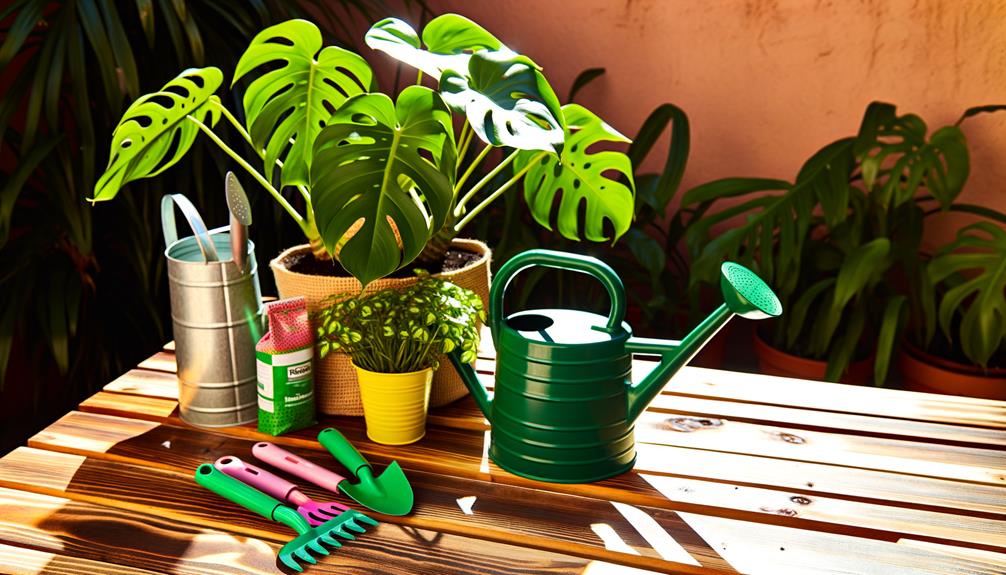
To maximize your Monstera Adansonii reaches its fullest potential, maintaining an ideal fertilizing schedule is essential. Apply a balanced, nutrient-rich fertilizer every 4-6 weeks during the growing season to support vigorous growth.
Avoid over-fertilizing, as it can lead to nutrient imbalances and root damage.
Optimal Fertilizing Schedule
Achieving a fuller Monstera Adansonii involves adhering to a consistent fertilizing schedule. Apply a balanced liquid fertilizer every four to six weeks during the growing season. This guarantees your plant receives the nutrients it needs for peak growth and development.
- Frequency: Fertilize every 4-6 weeks during the active growing period (spring and summer).
- Concentration: Dilute the fertilizer to half the recommended strength to prevent root burn.
- Application: Water the plant thoroughly before fertilizing to avoid nutrient shock.
- Observation: Monitor the plant for signs of nutrient deficiency or over-fertilization.
- Rest Period: Cease fertilization during fall and winter when the plant’s growth slows down.
Nutrient-Rich Fertilizers
Selecting nutrient-rich fertilizers ensures that your Monstera Adansonii receives the essential elements needed for robust and healthy growth. Choose a balanced, water-soluble fertilizer with an N-P-K ratio of 20-20-20 or 10-10-10.
Nitrogen (N) encourages lush foliage, phosphorus (P) supports root development, and potassium (K) boosts overall plant vigor. Administer the fertilizer every 4-6 weeks during the growing season, diluting it to half the recommended strength to avoid over-fertilization.
Additionally, micronutrients like iron, magnesium, and calcium are vital for preventing deficiencies. Regularly monitor leaf color and growth patterns to adjust your fertilizing regimen as necessary.
Pruning Techniques
When pruning Monstera Adansonii, always use sterilized tools to prevent disease and promote healthy growth. Pruning encourages bushier growth and removes damaged or leggy sections. Trim just above a node, where leaves and roots emerge, to stimulate new shoots. Regular pruning fosters a fuller appearance and improves overall plant vigor.
Here are key techniques:
- Sterilize tools before each cut with rubbing alcohol or a bleach solution to avoid pathogen transfer.
- Remove yellow or damaged leaves to direct energy towards healthy growth.
- Trim back long stems to maintain a compact shape and encourage lateral growth.
- Prune in the growing season (spring and summer) for best recovery.
- Avoid excessive pruning; leave at least two-thirds of the plant intact to promote robust health.
Propagation Methods
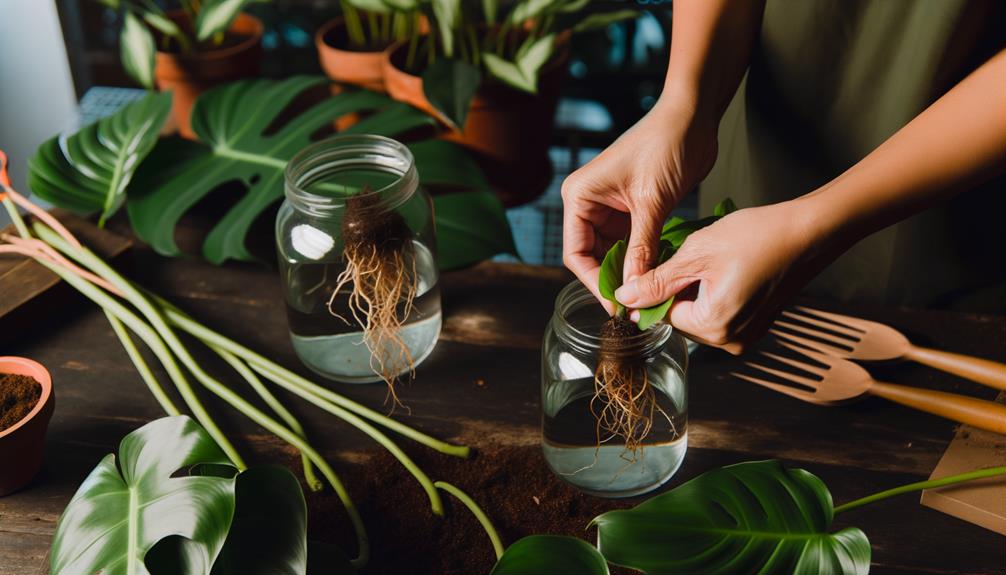
After mastering pruning techniques, you can further enhance the fullness of your Monstera Adansonii by employing effective propagation methods.
Start by selecting a healthy stem with at least one node and a few leaves. Use sterilized pruning shears to make a clean cut below the node. Place the cutting in water or moist sphagnum moss, making sure the node remains submerged.
Maintain high humidity and indirect light to promote root development. Once roots are 2-3 inches long, transplant the cutting into a well-draining potting mix. This new plant will contribute to the overall bushiness of your Monstera Adansonii.
Regularly monitor for root rot and pests to guarantee the propagated sections thrive alongside the original plant.
Support Structures
Utilizing appropriate support structures can significantly enhance the vertical growth and overall fullness of your Monstera Adansonii. By providing a framework, you encourage the plant’s natural climbing habit, promoting healthier and more robust development.
Here are some recommended support structures:
- Moss Poles: Retain moisture, providing a humid environment ideal for aerial roots.
- Trellises: Offer a sturdy framework for the plant to attach and climb.
- Bamboo Stakes: Simple and effective, allowing for easy adjustments as the plant grows.
- Coir Poles: Made from coconut fibers, these are eco-friendly and support strong root attachment.
- Wall-mounted Supports: Utilize vertical space, ideal for creating a living wall effect.
Implementing these structures guarantees your Monstera Adansonii thrives, exhibiting lush and fuller growth.
Pest Management

Effective pest management is essential for maintaining the health and vibrancy of your Monstera Adansonii. Regularly inspect your plant for common pests like spider mites, aphids, and mealybugs.
Early detection is key, so utilize a systematic approach:
| Pest | Symptom | Treatment |
|---|---|---|
| Spider Mites | Fine webbing on leaves | Neem oil or insecticidal soap |
| Aphids | Sticky residue, yellowing | Spray with soapy water |
| Mealybugs | Cotton-like masses on stems | Alcohol swabs or systemic insecticide |
Ensure good air circulation and avoid overwatering to prevent pest proliferation. Quarantine any new plants before introducing them to your Monstera’s environment. By following these guidelines, you can effectively manage pests and promote a fuller, healthier plant.
Rotating for Even Growth
To ensure your Monstera Adansonii grows evenly and maintains a symmetrical shape, regularly rotate the pot by 90 degrees every week. This practice guarantees that all sides of the plant receive equal light exposure, promoting balanced growth. Uneven light can cause the plant to lean or grow disproportionately toward the light source.
Key tips for effective rotation:
- Consistency is essential: Rotate your pot at the same time each week.
- Mark the pot: Use a marker or sticker to track the rotation angle.
- Monitor light intensity: Make sure the plant receives sufficient, indirect light from all angles.
- Observe plant response: Adjust rotation frequency if you notice uneven growth.
- Combine with pruning: Pair rotation with regular pruning to encourage fuller foliage.
Seasonal Care Adjustments
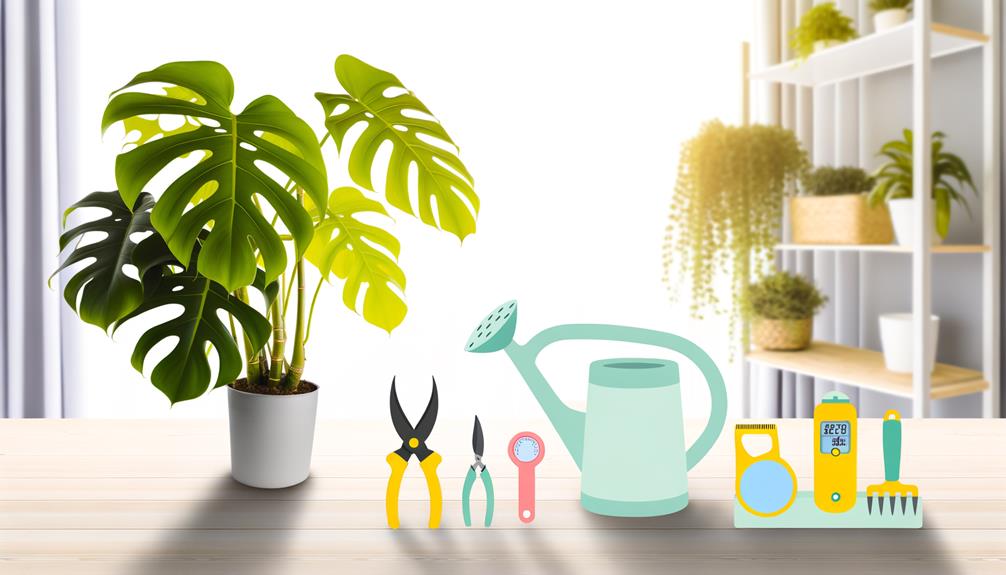
To maximize your Monstera Adansonii thrives year-round, you need to adjust its care based on seasonal changes.
Pay attention to variations in light requirements, temperature, and humidity levels, as well as necessary modifications to the watering schedule.
These adjustments will promote ideal growth and maintain plant health.
Light Requirements Variation
Monstera adansonii thrives best when its light exposure is adjusted seasonally. This involves securing bright, indirect light during the growing season and slightly reducing light during the dormant months. This seasonal adjustment mimics the plant’s natural habitat and promotes fuller growth.
Be sure you position your plant near an east or west-facing window in spring and summer, where it can get filtered light. During autumn and winter, move it a bit further from the window to prevent light stress.
- Place near a bright window, avoiding direct sunlight.
- Rotate the plant periodically for even light distribution.
- Use sheer curtains to filter intense light.
- Supplement with grow lights if natural light is insufficient.
- Monitor leaf color; pale leaves indicate excess light, while dark leaves suggest too little.
Temperature and Humidity
Just as light conditions influence Monstera adansonii‘s growth, temperature and humidity play a vital role in guaranteeing its foliage remains lush and vibrant.
Aim to maintain a consistent temperature between 65-85°F (18-29°C) to replicate its native tropical environment. Sudden temperature drops can stress the plant, leading to leaf loss.
Humidity is equally essential; aim for 60-80% relative humidity. Use a hygrometer to monitor levels accurately. During winter, when indoor air is typically drier, consider using a humidifier or placing the plant on a humidity tray. Grouping plants together can also create a microenvironment with higher humidity.
Watering Schedule Changes
Adjusting your watering schedule throughout the year is crucial for maintaining a healthy and fuller Monstera adansonii. Seasonal variations greatly impact the plant’s water requirements. During the growing season (spring and summer), increase watering frequency to support active growth.
In contrast, reduce watering during the dormant period (fall and winter) to prevent root rot.
Key adjustments include:
- Spring/Summer: Water when the top 1-2 inches of soil are dry.
- Fall/Winter: Allow the top 2-3 inches of soil to dry before watering.
- Humidity: Monitor and adjust for indoor humidity levels, ideally around 60%.
- Soil: Ensure well-draining soil to prevent waterlogging.
- Container: Use pots with drainage holes to facilitate excess water removal.
How To Prune Monstera Adansonii
To prune a Monstera Adansonii, follow these steps:
- Tools: Use clean, sharp pruning shears or scissors to prevent damage and reduce the risk of disease.
- Timing: Prune during the growing season (spring and summer) when the plant is actively growing.
- Inspect the Plant: Look for yellowing, damaged, or leggy stems and leaves that need removal.
- Cut at the Node: Make cuts just above a node (the point where leaves and roots grow). This encourages new growth from that point.
- Remove Dead/Damaged Parts: Cut off any yellowing, brown, or damaged leaves and stems. Dispose of these parts properly.
- Shape the Plant: Prune to shape the plant, remove leggy growth, and encourage bushier growth. Cut back any excessively long stems to a desired length.
- Promote Air Circulation: Remove crowded leaves and stems to improve airflow around the plant.
- Propagation: You can use healthy cuttings for propagation. Place the cuttings in water or a moist soil mix to root.
Regular pruning helps maintain the health and appearance of your Monstera Adansonii, promoting vigorous growth and a fuller plant.
Conclusion
To make your Monstera adansonii fuller, guarantee it gets proper light conditions and an ideal soil mix. Maintain a consistent watering schedule and peak humidity levels. Use specific fertilizing tips and provide support structures.
Implement effective pest management and rotate the plant for even growth. Remember seasonal care adjustments to keep it thriving.
By following these parallel practices, you’ll create a lush, vibrant Monstera adansonii that’s both scientifically healthy and aesthetically pleasing.

